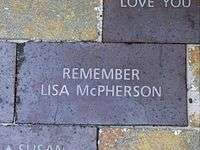Lisa McPherson Trust
|
A commemorative brick laid by the trust | |
| Formation | 1999 |
|---|---|
| Type | Educational |
| Legal status | For-profit |
| Purpose | Criticism of Scientology |
| Headquarters | Clearwater, Florida, United States |
| Leader | Bob Minton |
The Lisa McPherson Trust was an organisation created in 1999 by Bob Minton.[1] The trust was named after Lisa McPherson, a Scientology member who died in 1995 after being in the Church of Scientology’s care for 17 days. Their stated goal was to "expose the deceptive and abusive practices of Scientology and help those victimized by [the Church of Scientology]."[2]
Of the five staff members at the Lisa McPherson trust, 4 were former members of Scientology.[3]
History
The LMT staff included Stacy Brooks (President), Jesse Prince (Vice-President), Teresa Summers (Vice-President), Mark Bunker (Videographer), Jeff Jacobsen (Librarian), Robert Peterson (Office Manager), and Ingrid Wagner (Reception).
Controversy
Location
The company’s headquarters were located in downtown Clearwater, Florida. Many property managers denied the group access to their buildings after being contacted by members of Scientology.[4] Eventually, the group purchased a building at 33 N Fort Harrison Ave, which was situated 30 feet from Scientology buildings. Scientology offered to buy the building out from Minton but the property manager declined.[5]
Picketing
The company frequently engaged in pickets in downtown Clearwater. On the anniversary of Lisa McPherson’s death in 1999, the group used a projector to beam a message on the side of the Fort Harrison Hotel which read: "Lisa McPherson: We will never forget you."[6] An injunction was quickly sought against the group and a no-picket zone was established in front of Scientology buildings. Church members and trust members were also ordered to keep 10 feet away from each other at all times.[7] In 2001 this injunction was expanded by a county judge. The new order prevented either side from yelling, shouting, whistling, singing, blowing a horn whistle or other noisemaker, or otherwise creating noise which would disturb "reasonable persons of ordinary sensibilities." It also expanded the no-picket zone to include the area across the street from Scientology’s dining hall. The new order also required trust members to inform the police of any picket an hour in advance of the event.[8]
To enforce this ruling, Clearwater city painted two white lines across Watterson Avenue, stating that while Scientologists were loading or unloading buses in the area, the trust staff and members could not enter it.[9]
Legal problems
In late 2001, Scientology named the Lisa McPherson Trust as co-defendants in a case they had brought against the estate of Lisa McPherson.[10]
For-profit status
Bob Minton claimed that the trust had a for-profit status to allow them to hide financial and other records from the Church of Scientology.[11] Scientologists claimed that the for-profit status was proof that the group was created in order to allow Minton to recuperate the almost $2.5 million that he had put towards creating the group. [12]
Reaction from the Church of Scientology
The Church vehemently opposed the creation of the trust. They levelled many accusations against it including allegations that the trust was violently attempting to deprogram ex-Scientologists.[3] Scientology hired off-duty police officers, who were paid close to $150,000 over the course of 15 months,[8] to ensure that trust members stayed 10 feet away from Scientology buildings and parishioners at all times.[13]
Closure of the trust
The trust was disbanded in November 2001.[10] Minton cited mounting legal pressure from Scientology as the official reason. The closure of the trust was delayed for some months as a judge ordered that Scientology could conduct an official review of all of the Trust’s records. This included phone records and financial records which were later produced in court.[14]
References
- ↑ Frank Nordhausen (May 30, 2002). "The Man Who Fell Over". Berliner Zeitung. Retrieved April 17, 2010.
- ↑ "The Lisa McPherson Trust: R.I.P.". Naples Daily News. November 4, 2001. Retrieved April 17, 2010.
- 1 2 THOMAS C. TOBIN (January 6, 2000). "Scientology foe buys nearby property". St. Petersburg Times. Retrieved April 17, 2010.
- ↑ Patricia Greenway (January 12, 2000). "Trust's goal: Truth about Scientology". St. Petersburg Times. Retrieved April 17, 2010.
- ↑ THOMAS C. TOBIN (January 6, 2000). "Scientology foe sets up office close to church". St. Petersburg Times. Retrieved April 2010. Check date values in:
|access-date=(help) - ↑ THOMAS C. TOBIN (December 5, 1999). "Scientology foe moves in, digs in for a long fight". St. Petersburg Times. Retrieved April 17, 2010.
- ↑ DEBORAH O'NEIL (May 18, 2002). "Man spent millions fighting Scientology". St. Petersburg Times. Retrieved April 17, 2010.
- 1 2 ROBERT FARLEY (July 28, 2001). "Judge rebukes Scientologists, critics". St. Petersburg Times. Retrieved April 17, 2010.
- ↑ THOMAS C. TOBIN (February 6, 2000). "How much oddity can one town take?". St Petersburgh Times. Retrieved April 17, 2010.
- 1 2 DEBORAH O'NEIL (November 3, 2001). "Scientology critics to decamp". St. Petersburg Times. Retrieved April 17, 2010.
- ↑ Bob Minton (March 18, 2000). Bob Minton at CULTinfo - 2000 (Website). XenuTV.com.
- ↑ DEBORAH O'NEIL (December 9, 2001). "Church loads up for one last fight". St. Petersburg Times. Retrieved April 17, 2010.
- ↑ DEBORAH O'NEIL (March 11, 2001). "Church pays those it reviled". St. Petersburg Times. Retrieved April 17, 2010.
- ↑ DEBORAH O'NEIL (July 7, 2002). "HOW SCIENTOLOGY TURNED ITS BIGGEST CRITIC". St. Petersburg Times. Retrieved April 17, 2010.
